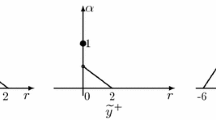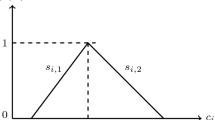Abstract
The paper is concerned with linear programming problems whose input data may be intuitionistic fuzzy (IF) while the values of variables are always real numbers. We propose rather general approach to this type of problems based on level sets, and present recent results for problems in which the notions of feasibility and optimality are based on the IF relations. Special attention is devoted to the weak and strong duality.
Similar content being viewed by others
References
Atanassov, K. T. (1986). Intutionistic fuzzy sets. Fuzzy Sets and Systems, 20, 87–96.
Bector, C. R., & Chandra, C. (2002). On duality in linear programming under fuzzy environment. Fuzzy Sets and Systems, 125, 317–325.
Bellman, R. E., & Zadeh, L. E. (1970). Decision making in a fuzzy environment. Management Science, 17, B141–B164.
Dubois, D. (2011). The role of fuzzy sets in decision sciences: Old techniques and new directions. Fuzzy Sets and Systems, 184, 3–28.
Dubey, D., Chandra, S., & Mehra, A. (2012). Fuzzy linear programming under interval uncertainty based on IFS representation. Fuzzy Sets and Systems, 188(1), 68–87.
Dubois, D., & Prade, H. (1983). Ranking fuzzy numbers in the setting of possibility theory. Information Sciences, 30, 183–224.
Dubois, D. (1987). Linear programming with fuzzy data. In J. Bezdek (Ed.), Analysis of fuzzy information. USA: CRC Press—Technology and Engineering Taylor and Francis Group.
Dubois, D., Gottwald, S., Hajek, P., Kacprzyk, J., & Prade, H. (2005). Terminological difficulties in fuzzy set theory the case of intuitionistic fuzzy sets. Fuzzy Sets and Systems, 156(3), 485–491.
Gupta, S. K., & Dangar, D. (2014). Duality for a class of fuzzy nonlinear optimization problem under generalized convexity. Fuzzy Optimization and Decision Making, 13, 131–150.
Hamacher, H., Lieberling, H., & Zimmermann, H.-J. (1978). Sensitivity analysis in fuzzy linear programming. Fuzzy Sets and Systems, 1, 269–281.
Inuiguchi, M. (2007). On possibilistic/fuzzy optimization: Foundations of fuzzy logic and soft computing. In P. Melin et al. (Eds.) Proceedings LNAI4529 12th International fuzzy systems association world congress IFSA (pp. 351–360). Mexico: Cancun.
Inuiguchi, M., Ichihashi, H., & Kume, Y. (1992). Some properties of extended fuzzy preference relations using modalities. Information Sciences, 61, 187–209.
Inuiguchi, M., Ichihashi, H., & Kume, Y. (1992). Relationships between modality constrained programming problems and various fuzzy mathematical programming problems. Fuzzy Sets and Systems, 49(3), 243–259.
Inuiguchi, M., Ramík, J., Tanino, T., & Vlach, M. (2003). Satisficing solutions and duality in interval and fuzzy linear programming. Fuzzy Sets and Systems, 135, 151–177.
Kuhn H. W. (1976). Nonlinear programming: A historical view. In Proceedings SIAM–AMS, vol. 9 (pp.1–26). Rhode Island: AMS Providence.
Mielcova, E. (2015). Ordering relations over intuitionistic fuzzy quantities: Lecture notes in computer science. In I. Rojas, G. Joya, A. Catala (Ed.), International Work—Conference on Artificial Neural Networks (advances in computational intelligence) IWANN.
Nachammai, A. L., & Thangaraj, P. (2012). Solving intuitionistic fuzzy linear programming problem by using similarity measures. European Journal of Scientific Research, 72(2), 204–210.
Ralescu, D. A. (1992). A generalization of the representation theorem. Fuzzy Sets and Systems, 51, 309–311.
Ramík, J. (2005). Duality in fuzzy linear programming: Some new concepts and results. Fuzzy Optimization and Decision Making, 4, 25–39.
Ramík, J. (2006). Duality in fuzzy linear programming with possibility and necessity relations. Fuzzy Sets and Systems, 157, 1283–1302.
Ramík, J., & Vlach, M. (2001). Generalized concavity in optimization and decision making. Boston, Dordrecht: Kluwer.
Ramík, J., & Vlach, M. (2004). A non-controversial definition of fuzzy sets. Transactions on rough sets II: Rough sets and fuzzy sets (pp. 201–207). Berlin, Heidelberg: Springer.
Rödder, W., & Zimmermann, H.-J. (1980). Extremal methods and system analysis: Duality in fuzzy linear programming (pp. 415–429). New York: Berlin.
Rommelfanger, H., Slowinski, R. (1998). Fuzzy linear programming with single or multiple objective functions: The handbooks of fuzzy sets series. Fuzzy sets in decision analysis, operations research, and statistics.179–213. Boston-Dordrecht-London: Kluwer.
Soyster, A. L. (1974). A duality theory for convex programming with set-inclusive constraints. Operations Research, 22, 892–898.
Stanciulescu, C., Fortemps, P., Install, M., & Wertz, V. (2003). Multiobjective fuzzy linear programming problems with fuzzy decision variables. European Journal of Operational Research, 149, 654675.
Thuente, D. J. (1980). Duality theory for generalized linear programs with computational methods. Operations Research, 28, 1005–1011.
Verdegay, J. L. (1984). A dual approach to solve the fuzzy linear programming problem. Fuzzy Sets and Systems, 14, 131–141.
Wu, H.-C. (2003). Duality theory in fuzzy linear programming problems with fuzzy coefficients. Fuzzy Optimization and Decision Making, 2, 61–73.
Yager, R. R. (2009). Some aspects of intuitionistic fuzzy sets. Fuzzy Optimization and Decision Making, 8, 67–90.
Zadeh, L. A. (1965). Fuzzy sets. Information and Control, 8, 338–353.
Zimmermann, H.-J. (1978). Fuzzy programming and linear programming with several objective functions. Fuzzy Sets and Systems, 1, 45–55.
Acknowledgments
This work was supported by GACR Project No. 14-02424S. The authors are thankful to our colleague Radomir Perzina, Ph.D., who prepared an Excel sheet enabling numerical calculations performed in Sect. 5.
Author information
Authors and Affiliations
Corresponding author
Rights and permissions
About this article
Cite this article
Ramík, J., Vlach, M. Intuitionistic fuzzy linear programming and duality: a level sets approach. Fuzzy Optim Decis Making 15, 457–489 (2016). https://doi.org/10.1007/s10700-016-9233-0
Published:
Issue Date:
DOI: https://doi.org/10.1007/s10700-016-9233-0




